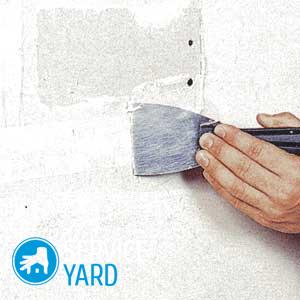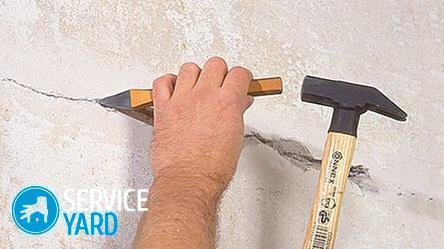How to remove old plaster from the walls?

During the overhaul, we always have a lot of questions, and we are trying to find answers to them. For example, how to remove old plaster from the walls? Do I need to remove it at all? In this article we will give answers to your questions. The case is not simple, but if you understand the intricacies, it will be much easier to do it yourself.
to contents ↑Before removing the plaster from the wall
Even if you yourself plastered these walls, you do not know in what exact condition they are now. To do this, you need to conduct a preliminary analysis of the coating in order to understand how to remove the old plaster from the walls:
- Take a spatula, which you will later process these walls.
- Tap the handle of this tool every 30-40 centimeters.
Important! If you hear booming blows, how would you hit concrete, this means that the plaster is very strong and you can leave it. But if the sound is dull, then this means that there is a small void between the wall and this layer and the top layer is no longer strong.
How else can you find out that the plaster is bad and will not last long? - Very simple! Over time, the upper layer bursts from moisture and therefore cracks will be visible on the wall - this means that it can be safely removed.
to contents ↑Important! Wet spots on the wall and the appearance of the fungus testify to the quality of the plaster.
Which tool to use to remove the old layer?
Before you start the repair, stock up on the necessary tools. To determine which device you need, set the strength of the wall coating. To completely remove the old plaster from the walls, you need:
- gloves
- goggles and a respirator;
- ax and hammer;
- chisel;
- putty knife;
- puncher and grinder;
- grinder machine;
- sandpaper;
- sprayer;
- metal brush;
- shovel, brooms, etc. - all that you need to clean the crumbling plaster.
to contents ↑Important! Perhaps you will not use each of these tools, since it all depends on the degree of wear on the surface.
How to remove old plaster from the wall without unnecessary labor
There are cases when the coating should not be completely removed - its cracks do not always indicate that it is very weak. The most important criterion here is the final finish (paint or wallpaper), which you need to get rid of:
- To remove the wallpaper, it is enough to wet them and remove them with a spatula - it will be easier to remove.
- We remove the paint with the same tool, having previously tapped it with a hammer or moistened with a suitable solvent.
If you saw cracks on the finish, they can be locally repaired without the laborious work of removing the plaster completely:
- Carefully inspect and check if their edges are crumbling (tapping method).
- Next, take a sharp object and widen the crack so that the letter “V” forms on its separation.
- When you begin to work on the wall again, fill the primed cracks with two-thirds of the mixture, and then cover with soil from above to smooth the surface.
- Rub the marks from the areas where there were cracks.

Sometimes there is a need to remove the old coating, because it makes no sense to take care of it - so we will spend more time, effort and money.In addition, there are modern high-quality materials that have in their advantage a very good service life.
to contents ↑Important! TOhow to remove the plaster from the wall without unnecessary labor? - The old layer must be saturated with moisture. Treat the entire surface with warm water - it will be easier to remove it. In addition, this method will reduce the amount of dust when removing the finish.
Several options for removing old plaster from walls
There are two methods for removing old plaster: the use of force, the method of gradual removal of material:
- The first method is much faster than the second, but it requires a lot of effort. In order to use it, you need to have at your disposal a hammer with a chisel or an ax. You can do both, if the ax - take the one that you do not mind, a spatula, a puncher and a grinder.
- In the second method, we need a grinder and nozzles corresponding to it.
Important! To protect against dust, use gloves, goggles and a respirator.
Power Method:
- Wall preparation. Wet the walls well with water and wait for it to soak. If you see that the surface dries quickly, then there is not enough water - you still need to moisten it. A check for moisture saturation can be done by dropping a spatula into the wall to the maximum possible depth.
- Initial processing. We take an ax and a hammer in order to tap the upper part of the wall and achieve falling apart of individual pieces. We make notches with a hammer and pry them to remove parts of the plaster.
Important! With a chisel, you can bring down a lot more trim.
- Chiselling. In old houses, most often stucco contains a lot of cement, so it’s pointless to use tools such as an ax or chisel, you can only spoil them. A puncher is suitable for this - it will cope with this task. To do this, switch this tool to the chiselling mode and chip the pieces of plaster, placing the device at a slight angle to the wall.
- Cutting. Since it is sometimes impossible to even remove old plaster from the walls even with a puncher (there used to be a lot of cement in old mixes for walls), use a grinder (install a stone disk on it). Make cuts along the length and width of the wall to make rectangles that will be easier to clean.
Important! Using a grinder, water the walls so that there is no dust.
Method of gradual removal of plaster:
- Impregnation. It is very necessary to wet the walls so that they are as humid as possible. This will make your work much easier, because you have to work manually or using a special device.
- Manual processing. If the plaster is very thin, then you can do with sandpaper with large grains (put it on a grater). Make movements in circles, and as often as possible remove the worn plaster from the paper, dipping it in water.
- Grinding machine. Use an abrasive wheel in the form of a nozzle and try not to wet it in water - it is better to spray the walls with a hand sprayer.
to contents ↑Stock footage
These tips will help you in the best way for you to make a quality repair. We wish you success!
- How to choose a vacuum cleaner taking into account the characteristics of the house and coatings?
- What to look for when choosing a water delivery
- How to quickly create comfort at home - tips for housewives
- How to choose the perfect TV - useful tips
- What to look for when choosing blinds
- What should be running shoes?
- What useful things can you buy in a hardware store
- Iphone 11 pro max review
- Than iPhone is better than Android smartphones



